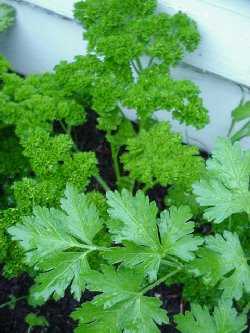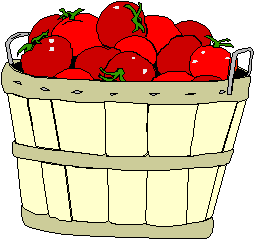Owing to the screen size of your device, you may obtain a better viewing experience by
rotating your device a quarter-turn (to get the so-called "panorama" screen view).
|
This page updated for 2022.
|
Click here for the site directory.
|
|
Please consider linking to this site!
|
Click here to email us.
|
Parsley
(Petroselinum crispum)
About Parsley

Pity the poor folk who think parsley is that junk massfood restaurants “adorn” your plate with (in the days of old, a parsley sprig on a diner’s plate was supposed to signify that the master chef had personally attended to that order—today it’s an uncomprehended habit). Fresh parsley of a good variety is a moderately strong flavoring, giving a good, clean freshness to many dishes; it is good enough to eat on its own (which makes it, by us, one of the great herbs); one of our favorite uses is garlic-parsley finger sandwiches (a huge platter of those will disappear mighty fast around here!), or it can be the base and main ingredient in some wonderful green sauces. Indeed, at least two leading seedsmen list parsley on its own with the vegetables, not in the herb/spice pages.
Cultivars
Parsley comes in many named varieties—though probably fewer than a review of seedmen’s catalogues might suggest, as the same types are often called different things by different vendors.
Parsley types broadly divide into two: flat-leaf (variously styled single, plain, Italian, Dark Green Plain Leaf, Catalogno, or Flat Leaf) and curly. Prevailing opinion is that the flat-leaf varieties have better and stronger flavor, though not all expert sources agree that there is a difference. The best for culinary purposes appear to be the so-called Italian (or sometimes “French”) or Plain-Leaf types, which are P. crispum var. neapolitanum (also seen as var. neapolitanum Danert, which we presume but can’t guarantee is the same thing). Our recomendation is to look for types designated Plain or Plain Italian Dark Green or something much like. Some seed houses distinguish Catalogna from “ordinary“ flat-leaf parsley; that may be their way of designating the neapolitanum type.
There is also a now-obscure but apparently most praiseworthy variety of parsley known as Cilician parsley, popular in the Middle Ages and in the Middle East—it originated in Cilicia, once in Armenia, now in Turkey. It is said to have a “citrus after-taste”, and to be winter-hardy and easily grown. It is very difficult to locate supplies, but at least a couple of U.S. seedsman currently offer it.
Planting
Parsley is a true biennial. If you like it anywhere near as much as we do, you dedicate a fair-sized patch of ground as a parsley bed, plant it densely, and let it re-seed itself annually, which it readily does in most climates. But if you are just keeping a few specimen plants, remember to have some of each year’s growth.
In our climes, parsley should do well in full sun, though in warmer areas it appreciates a little shade in mid-summer. It is not fussy about soil, save for the usual herbal desire for excellent drainage, so as to avoid “wet feet”. Some say fertilize well, others say not too much; since we’re growing it for leaf, not seed, we’d say if you have to err with fertilization, let it be on the generous side.
Parsley seed is notoriously hard to germinate, but much of that reputation is ill-deserved, and flows from a failure to recognize the need for “stratification” of the seed, which is the process of keeping the seed damp (as between sheets of damp paper towel) and cold (say refrigerator temperature) for some time (say a month or two) prior to planting, so as to replicate the seed’s natural habitats. (Periodically refresh the paper towels’ moistness.) Note: parsley seed does not store well: always use fresh, new-bought seed for parsley.
If you are planting a good area, as we do, sow seed direct where it is to grow; pantywaists just growing a plant or two can start (and, for that matter, maintain) seedlings indoors. Parsley tolerates cool and damp conditions, so you can sow fairly early in the spring, though a hard frost on young seedlings is not A Good Thing, so don’t go crazy with earliness.
Sow seeds shallow, about ⅛" down. Space plants at about 6 inches, or—if you’re planting a large area—broadcast it generously and later thin seedlings as necessary (making good culinary use of the thinnings!).
Frozen parsley will work in virtually all cooking applications, but the greedier among us will also grow some indoors during the winter to have a continuous supply for the occasional need for fresh parsley; it pots up quite nicely.
Growing
Keep parsley well-watered at all stages of growth; do not ever let it really dry out. A light mulch, say grass clippings, helps hold moisture in the soil. A mild liquid fertilizer applied once or twice a season can’t hurt and might help, though we have found parsley, treated well otherwise, to be pretty hardy.
When taking leaves for use (or freezing), snip stalks off close to the ground, starting with the outside ones (that practice best encourages new growth).
As parsley is a biennial, be sure to generously seed it again in its second year, so you have plenty of plants in each year of the cycle; thereafter, it should self-sow satisfactorily.
Relevant Links
Besides any links presented above on this page, the following ought to be especially helpful.
Return to the top of this page.
If you find this site interesting or useful, please link to it on your site by cutting and pasting this HTML:
The <a href="https://growingtaste.com/"><b>Growing Taste</b></a> Vegetable-Gardening Site
—Site Directory—
Search this site, or the web
-
Background Information
about the purposes and design of this site
- Site Front Page
-
Introduction

- An Apologia: why one should cultivate one's garden
- Deep-Bed Gardening (forthcoming)
- Container Gardening (forthcoming)
- Vegetarian and Organic Considerations (forthcoming)
-
Recommended Crops for a home garden, by variety
-
Gardening information and aids
-
Miscellaneous Information of interest to the home gardener
Since you're growing your own vegetables and fruits, shouldn't you be cooking them in the best way possible?
Visit The Induction Site to find out what that best way is!
|
If you like good-tasting food, perhaps you are interested in good-tasting wines as well?
Visit That Useful Wine Site for advice and recommendations for both novices and experts.
|

|
This site is one of The Owlcroft Company family of web sites. Please click on the link (or the owl)
to see a menu of our other diverse user-friendly, helpful sites.
|
|
 Like all our sites, this one is hosted at the highly regarded Pair Networks,
whom we strongly recommend. We invite you to click on the Pair link for more information on getting your site or sites hosted on a first-class service.
Like all our sites, this one is hosted at the highly regarded Pair Networks,
whom we strongly recommend. We invite you to click on the Pair link for more information on getting your site or sites hosted on a first-class service.
|
|
All Owlcroft systems run on Ubuntu Linux and we heartily recommend it to everyone—click on the link for more information.
|
Click here to send us email.
Because we believe in inter-operability, we have taken the trouble to assure that
this web page is 100% compliant with the World Wide Web Consortium's
XHTML Protocol v1.0 (Transitional).
You can click on the logo below to test this page!
You loaded this page on
Tuesday, 15 April 2025, at 11:09 EDT.
It was last modified on Monday, 10 January 2022, at 06:38 EST.
All content copyright ©1999 - 2025 by
The Owlcroft Company

